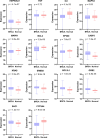Mechanism exploration of di(2-ethylhexyl) phthalate (DEHP)-induced breast cancer via network toxicology and molecular docking analysis
- PMID: 40715557
- PMCID: PMC12297483
- DOI: 10.1038/s41598-025-13201-1
Mechanism exploration of di(2-ethylhexyl) phthalate (DEHP)-induced breast cancer via network toxicology and molecular docking analysis
Abstract
Disease caused by plasticizers has received increasing attention. Di(2-ethylhexyl) phthalate (DEHP), one of the most widely exposed plasticizers, has been shown to be closely associated with the development of breast cancer (BRCA) in epidemiological studies, but the specific mechanistic targets and related pathways are still unclear. In this study, we aimed to elucidate the potential pathogenic targets and mechanisms of DEHP-induced BRCA through network toxicology and molecular docking. Databases including GeneCards, OMIM, ChEMBL, and SwissTargetPrediction were first used to identify DEHP-related targets and BRCA-related targets, and 691 potential targets were obtained from the intersection analysis. Gene Ontology (GO) and Kyoto Encyclopedia of Genes and Genomes (KEGG) enrichment analyses were performed to clarify the biological functions and pathways of potential targets. Protein-protein interaction (PPI) analysis revealed the interactions between potential targets, and 14 hub targets of DEHP-induced BRCA were further screened. To verify the clinical significance of the hub targets, the expression of the target proteins was verified in the TCGA database, and the affinity between DEHP and 12 key targets (hub targets with p < 0.05) was determined via molecular docking. Our study provides a theoretical basis for DEHP-induced BRCA from the "Homo sapiens" perspective and reveals the potential risks caused by exposure to DEHP, thus providing new strategies for the prevention and treatment of DEHP-induced BRCA.
Keywords: Breast cancer; Di(2-ethylhexyl) phthalate; Molecular docking; Network toxicology.
© 2025. The Author(s).
Conflict of interest statement
Declarations. Competing interests: The authors declare no competing interests.
Figures






Similar articles
-
Toxicity and mechanism of bis(2-ethylhexyl) phthalate in premature ovarian failure: A network toxicology prediction and molecular docking analysis.Medicine (Baltimore). 2025 Jul 18;104(29):e43404. doi: 10.1097/MD.0000000000043404. Medicine (Baltimore). 2025. PMID: 40696610 Free PMC article.
-
Impact of Di-(2-Ethylhexyl)-Phthalate on Metabolic Syndrome: Insights from Network Toxicology and Molecular Docking and Dynamics.Diabetes Metab Syndr Obes. 2025 Jul 8;18:2277-2288. doi: 10.2147/DMSO.S523668. eCollection 2025. Diabetes Metab Syndr Obes. 2025. PMID: 40655169 Free PMC article.
-
Unraveling the molecular mechanisms of PFOA in clear cell renal cell carcinoma through network toxicology and molecular docking strategies.Int J Surg. 2025 Jul 1;111(7):4842-4853. doi: 10.1097/JS9.0000000000002461. Epub 2025 May 12. Int J Surg. 2025. PMID: 40359556
-
Systematic review and meta-analysis of early life exposure to di(2-ethylhexyl) phthalate and obesity related outcomes in rodents.Chemosphere. 2017 Dec;188:174-181. doi: 10.1016/j.chemosphere.2017.08.165. Epub 2017 Aug 31. Chemosphere. 2017. PMID: 28886551
-
Medicine for chronic atrophic gastritis: a systematic review, meta- and network pharmacology analysis.Ann Med. 2023;55(2):2299352. doi: 10.1080/07853890.2023.2299352. Epub 2024 Jan 3. Ann Med. 2023. PMID: 38170849 Free PMC article.
References
-
- Bray, F. et al. Global cancer statistics 2022: GLOBOCAN estimates of incidence and mortality worldwide for 36 cancers in 185 countries. Ca-Cancer J. Clin.74, 229–263 (2024). - PubMed
-
- Bodaghi, A. An overview on the recent developments in reactive plasticizers in polymers. Adv. Technol.31, 355–367 (2020).
-
- Eales, J. et al. Human health impacts of exposure to phthalate plasticizers: An overview of reviews. Environ. Int.158, 106903 (2022). - PubMed
-
- Mughees, M., Chugh, H. & Wajid, S. Mechanism of phthalate esters in the progression and development of breast cancer. Drug Chem. Toxicol.45, 1021–1025 (2022). - PubMed
MeSH terms
Substances
LinkOut - more resources
Full Text Sources
Medical

